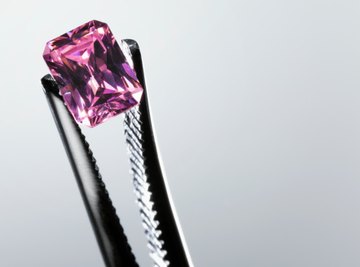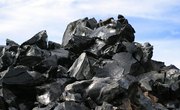
While many minerals form beautiful crystals, gemstones are the minerals that survive the wear and tear of being part of a piece of jewelry. Among the best-known gemstones are what were once known as the "precious" stones: diamonds, sapphires, topaz and emeralds, which are a variety of beryl. Other gemstones, including aquamarines (another form of beryl), tourmalines, zircons, spinels, peridots and garnets, give jewelers an amazing palette. Telling the difference between glass and these many gemstones can be challenging.
TL;DR (Too Long; Didn't Read)
Glass and gemstones can be differentiated by differences in physical properties. Even quartz gemstones, the gemstones chemically closest to glass, are distinctly different from glass. Glass has lower hardness, lower refractive index and lower density (specific gravity) than gemstones. The one exception, opal, has a distinct play of color that glass does not display.
Recognizing Glass
Glass comes in several varieties as well. In nature, obsidian or volcanic glass happens when lava cools so quickly that very few or no crystals form. Sometimes obsidian forms in balls called Apache tears.
But most glass is human-made. When found outside, broken glass has sharp edges with a shell-like, conchoidal fracture. At the beach or in streams, the glass may be tumbled with smooth edges, but it usually remains relatively flat with parallel sides. The most likely glass found in nature is soda-lime or window glass, which has a hardness of 5 to 5.5. The refractive index of glass ranges from 1.46 to 1.52. Glass does not have a crystalline structure. The density of glass ranges from 2.18 to 2.40 grams per cubic centimeter. In general, the edges of glass break easily, so glass "crystals" will show wear along the edges of facets, more than would be expected in gemstones. Chemically, glass is made from sand that is almost pure silicon dioxide with a few additives to lower the melting point of the silica sand and to add, when desired, color to the glass. Quartz, formed from silicon dioxide molecules, chemically is most similar to glass.
Mohs Hardness Scale
The Mohs Hardness Scale describes materials by their hardness, or resistance to damage. The hardest mineral of all, diamond, has a hardness of 10. Next comes corundum, number 9 on the Mohs hardness scale. Corundum includes the many shades of sapphire, from clear to yellow to blue as well as the red sapphire commonly called ruby. Next down the hardness scale lies topaz. From yellow and orange to bright blue, topaz ranks 8 on the hardness scale.
Beryl, the family of minerals that includes emerald, aquamarine and morganite, lies slightly below topaz on the Mohs Hardness scale, registering between 7.5 and 8. Varieties of quartz also may be found mounted as gemstones. Quartz, with its Mohs hardness of 7, can be found in a wide range of colors, from purple amethyst to clear rock crystal to yellow citrine. Many other gemstones like garnets, peridots, tourmalines, iolites, spinel and zircons fall between 6 and 7.5 on the hardness scale. All these gemstones scratch glass, if one cares to perform a hardness test, because the hardness of glass lies between 5 and 5.5.
Refractive Indices
Refraction occurs when light bends as it passes from one medium to another. The apparent bending of a pencil when placed in a glass of water illustrates refraction. The refractive index measures the degree of refraction. One method of testing refractive index uses oils with known refractive indices. If a gemstone has the same refractive index, the stone will disappear when placed in the matching oil. The refractive index of glass ranges from 1.46 to 1.52. Borosilicate glass, RI 1.47, disappears in vegetable oil. Gemstones, on the other hand, have higher refractive indices. Amethyst and citrine, two varieties of quartz, have an RI range of 1.54 to 1.55. Zircon ranges from 1.81 to 1.98 while diamond's RI is 2.42. The Refractive Index measures one aspect of the sparkle of gemstones, and glass just doesn't have the same effect on light.
Density and Specific Gravity
Density and specific gravity both measure the amount of matter, the mass, in a given space, the volume. Glass density, between 2.18 to 2.40, is lower than natural quartz. Gem-quality rose quartz has a density of 2.66. Beryl ranges from 2.72 (emeralds and aquamarines) to 2.80 to 2.91 (morganite), diamonds are at 3.52 and zircon is at 3.90 to 4.73. These illustrate how the density of gemstones exceeds the density of glass. In other words, glass will feel lighter than an equal size gemstone.
Play of Color
The gemstone opal displays unique flashes and displays of color that glass does not imitate. Opal's physical properties very closely match glass. The play of color caused by the layers of silica spheres within opal, however, make confusing opal with glass highly unlikely.
References
Tips
- When buying a diamond, ask for a certificate of authenticity from the Gemological Institute of America or an appraiser from the American Society of Appraisers.
About the Author
Karen earned her Bachelor of Science in geology. She worked as a geologist for ten years before returning to school to earn her multiple subject teaching credential. Karen taught middle school science for over two decades, earning her Master of Arts in Science Education (emphasis in 5-12 geosciences) along the way. Karen now designs and teaches science and STEAM classes.
Photo Credits
Jeffrey Hamilton/Photodisc/Getty Images
